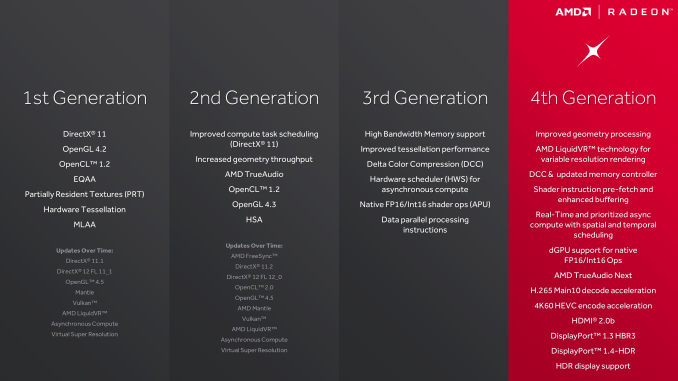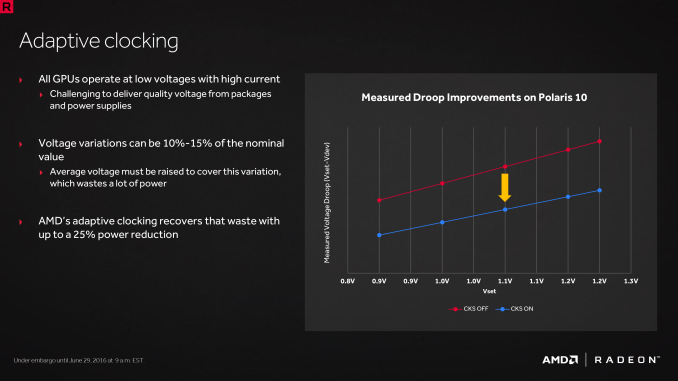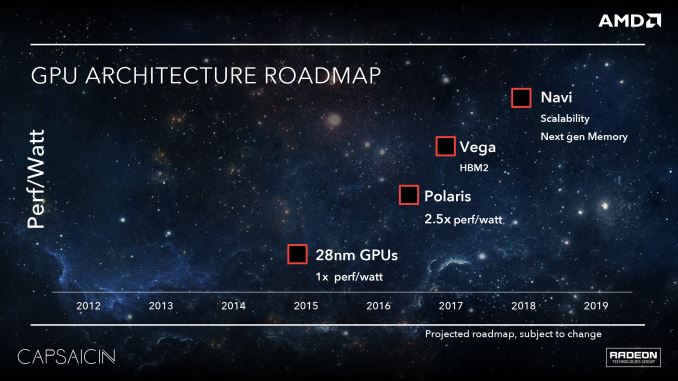The AMD Radeon RX 480 Preview: Polaris Makes Its Mainstream Mark
by Ryan Smith on June 29, 2016 9:00 AM ESTAMD's Path to Polaris
With the benefit of hindsight, I think in reflection that the 28nm generation started out better for AMD than it ended. The first Graphics Core Next card, Radeon HD 7970, had the advantage of launching more than a quarter before NVIDIA’s competing Kepler cards. And while AMD trailed in power efficiency from the start, at least for a time there they could compete for the top spot in the market with products such as the Radeon HD 7970 GHz Edition, before NVIDIA rolled out their largest Kepler GPUs.
However I think where things really went off of the rails for AMD was mid-cycle, in 2014, when NVIDIA unveiled the Maxwell architecture. Kepler was good, but Maxwell was great; NVIDIA further improved their architectural and energy efficiency (at times immensely so), and this put AMD on the back foot for the rest of the generation. AMD had performant parts from the bottom R7 360 right up to the top Fury X, but they were never in a position to catch Maxwell’s efficiency, a quality that proved to resonate with both reviewers and gamers.
The lessons of the 28nm generation were not lost on AMD. Graphics Core Next was a solid architecture and opened the door to AMD in a number of ways, but the Radeon brand does not exist in a vacuum, and it needs to compete with the more successful NVIDIA. At the same time AMD is nothing if not scrappy, and they can surprise us when we least expect it. But sometimes the only way to learn is the hard way, and for AMD I think the latter half of the 28nm generation was for the Radeon Technologies Group learning the hard way.
So what lessons did AMD learn for Polaris? First and foremost, power efficiency matters. It matters quite a lot in fact. Every vendor – be it AMD, Intel, or NVIDIA – will play up their strongest attributes. But power efficiency caught on with consumers, more so than any other “feature” in the 28nm generation. Though its importance in the desktop market is forum argument fodder to this day, power efficiency and overall performance are two sides of the same coin. There are practical limits for how much power can be dissipated in different card form factors, so the greater the efficiency, the greater the performance at a specific form factor. This aspect is even more important in the notebook space, where GPUs are at the mercy of limited cooling and there is a hard ceiling on heat dissipation.
As a result a significant amount of the work that has gone into Polaris has been into improving power efficiency. To be blunt, AMD has to be able to better compete with NVIDIA here, but AMD’s position is more nuanced than simply beating NVIDIA. AMD largely missed the boat on notebooks in the last generation, and they don’t want to repeat their mistakes. At the same time, starting now with an energy efficient architecture means that when they scale up and scale out with bigger and faster chips, they have a solid base to work from, and ultimately, more chances to achieve better performance.
The other lesson AMD learned for Polaris is that market share matters. This is not an end-user problem – AMD’s market share doesn’t change the performance or value of their cards – but we can’t talk about what led to Polaris without addressing it. AMD’s share of the consumer GPU market is about as low as it ever has been; this translates not only into weaker sales, but it undermines AMD’s position as a whole. Consumers are more likely to buy what’s safe, and OEMs aren’t much different, never mind the psychological aspects of the bandwagon effect.
Consequently, with Polaris AMD made the decision to start with the mainstream market and then work up from there, a significant departure from the traditional top-down GPU rollouts. This means developing chips like Polaris 10 and 11 first, targeting mainstream desktops and laptops, and letting the larger enthusiast class GPUs follow. The potential payoff for AMD here is that this is the opposite of what NVIDIA has done, and that means AMD gets to go after the high volume mainstream market first while NVIDIA builds down. Should everything go according to plan, then this gives AMD the opportunity to grow out their market share, and ultimately shore up their business.
As we dive into Polaris, its abilities, and its performance, it’s these two lessons we’ll see crop up time and time again, as these were some of the guiding lessons in Polaris’s design. AMD has taken the lessons of the 28nm generation to heart and have crafted a plan to move forward with the FinFET generation, charting a different, and hopefully more successful path.
Though with this talk of energy efficiency and mainstream GPUs, let’s be clear here: this isn’t AMD’s small die strategy reborn. AMD has already announced their Vega architecture, which will follow up on the work done by Polaris. Though not explicitly stated by AMD, it has been strongly hinted at that these are the higher performance chips that in past generations we’d see AMD launch with first, offering performance features such as HBM2. AMD will have to live with the fact that for the near future they have no shot at the performance crown – and the halo effect that comes with it – but with any luck, it will put AMD in a better position to strike at the high-end market once Vega’s time does come.













449 Comments
View All Comments
cjpp78 - Thursday, July 7, 2016 - link
weird, my reference xfx Rx 480 black edition came stock overclocked to 1328mhz. I've seen others clock reference to 1350+. Its not a good overclocker but it will overclockDemibolt - Friday, July 1, 2016 - link
Not here to argue, just fact checking.Currently, there are brand new GTX 970 (OC versions, not that it matters) available for $240.
hans_ober - Wednesday, June 29, 2016 - link
A bit disappointing, Perf/W is around GTX 980/970 levels = Maxwell. Not near Pascal.For the price? It's a good deal, but Perf/$ isn't as high as it was hyped to be.
PeckingOrder - Wednesday, June 29, 2016 - link
It's a terrible product. Look at the temps.http://media.bestofmicro.com/C/E/591422/original/0...
figus77 - Wednesday, June 29, 2016 - link
No one will buy one with the stock cooler. So, why bother for it?Namisecond - Wednesday, June 29, 2016 - link
I was going to pick one up today (stock model) at my local microcenter, but the temps and noise is making me pause until I get more verification on that...might as well wait for the 1060/ti that might be announced soon...TimAhKin - Wednesday, June 29, 2016 - link
And the card is not meant for 4K. No card stays cool or at decent temps like 60 degrees, in 4K.JoeyJoJo123 - Wednesday, June 29, 2016 - link
My GTX 970 does in 4K on Warframe. I disable AA (not need on 4k 24" screen) and other post-processing and lighting effects which get in the way of identifying enemies and allies quickly and efficiently.Speak for yourself. I'm getting tired of this whole "current gen video cardz can't HANDLE 4k!". At least define 4k as 4K resolution at maxed out settings on current gen AAA game titles, because at that point, you'd be correct. But just saying 4k can't be handled period is completely stupid and false.
eek2121 - Wednesday, June 29, 2016 - link
People do that all the time. When Xbox Scorpio was announced everyone was saying that there was no way it could do 4K, yet few are paying attention to the fact that xbox one games are designed around a slower version of the r7 260x. As an example, there is no doubt in my mind that the RX480 could easily scale these games to 4k.TimAhKin - Wednesday, June 29, 2016 - link
Do you understand my comment?This card(480) is not meant for 4K gaming and that temperature from the above picture is normal. I get 85-90 degrees as well in 4K.